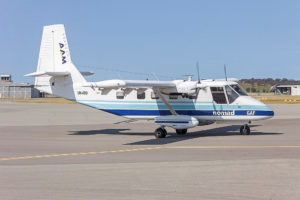
An Australian GAF Nomad
Photo credit: Bidgee
Why is it crucial for pilots to know the weight and balance of a loaded plane before take-off?
Ensuring that an aircraft stays within its weight and balance limits is of utmost importance for pilots before commencing a flight. If there is too much weight towards the back of the plane, the nose will become light, making the aircraft take off easily.
However, this can pose a problem during the approach to land where the pilot needs to push the nose down.
At this critical moment, a pilot’s instinct would be to reduce the engine power at low speed. This manoeuvre can lead to an awkward situation where the plane may just stall and drop off the sky unless it is at a sufficient altitude for a safe recovery.
On April 29th, 2013, a National Airlines Boeing 747-400 crashed shortly after take-off from Bagram Airfield in Afghanistan due to severe balance issues. Investigators determined that an improperly loaded cargo had come loose during take-off, shifting it to the rear of the plane. As a result, the aircraft was unable to regain control after stalling and crashed.
An aircraft must not only be well-balanced, it should also not be overloaded as this affects its performance. This is particularly critical on smaller or lighter planes.
In 1980, a small airliner operating out of a Chicago airport had a very close call when the captain realized that he needed more power and a longer distance to lift off the runway than expected.
Upon investigation, it was discovered that most of the passengers on board were coin collectors traveling to a convention with over a ton of coins in their carry-on bags. Thankfully, the runway was long enough for the safe take-off despite the plane being overweight.
On June 6th, 1976, tragedy struck when an Australian-built Nomad plane belonging to Sabah Air crashed while approaching to land at the Kota Kinabalu International Airport in Malaysia. This incident, known as the ‘Double Six Tragedy,’ claimed the lives of several local political leaders.
Investigators found that the Nomad aircraft was not operated within strict weight and balance limits. As a result, it exhibited unpredictable behaviour when flying at low speeds, particularly during landing.
Disturbingly, this crucial information was absent from the flight manual at the time of the crash. Since the aircraft was carrying excessive weight when landing at a low altitude (600 feet), the pilot had insufficient time to respond and manoeuvre the aircraft out of the spin, leading to the crash.
To balance the weight of the plane, the pilot must ensure an even distribution of passengers and cargo throughout the aircraft cabin.
Typically, pilots do not have sensors that can precisely identify which area of the plane is experiencing an excessive weight load. Instead, they rely on weight and balance calculations before take-off using load sheets provided by flight dispatchers.
View YouTube video on National Airlines Flight 102 – Crash Animation
here https://www.youtube.com/watch?v=X5OBsV82CD0
View YouTube video on Double Six Tragedy Documentary
here https://www.youtube.com/watch?v=ChWq0-gfALM